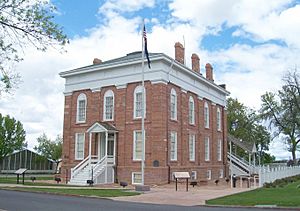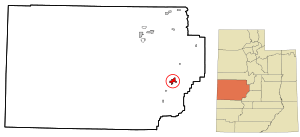Fillmore, Utah facts for kids
Quick facts for kids
Fillmore, Utah
|
|
|---|---|

Utah Territorial Statehouse
|
|

Location in Millard County and the state of Utah
|
|
| Country | |
| State | |
| County | Millard |
| Founded | 1851 |
| Named for | Millard Fillmore |
| Area | |
| • Total | 6.97 sq mi (18.04 km2) |
| • Land | 6.97 sq mi (18.04 km2) |
| • Water | 0.00 sq mi (0.00 km2) |
| Elevation | 5,072 ft (1,546 m) |
| Population
(2020)
|
|
| • Total | 2,592 |
| • Density | 371.88/sq mi (143.68/km2) |
| Time zone | UTC−7 (Mountain) |
| • Summer (DST) | UTC−6 (MDT) |
| ZIP code |
84631
|
| Area code(s) | 435 |
| FIPS code | 49-25510 |
| GNIS feature ID | 2410505 |
| Website | http://www.fillmorecity.org |
Fillmore is a city in Millard County, Utah, in the United States. It is the main city of the county. In 2020, about 2,592 people lived there.
The city is named after Millard Fillmore. He was the 13th President of the United States. He was president when Millard County was first created.
Fillmore was once the capital city of the Utah Territory. This was from 1851 to 1856. The old Utah Territorial Statehouse building is still standing today.
Contents
History of Fillmore
Fillmore was chosen to be the capital of the Utah Territory. This was because it was close to the center of the territory. In 1851, the Utah Territorial Legislature agreed to build the capital in the Pahvant Valley.
On October 28, 1851, Utah's governor, Brigham Young, picked the exact spot for Fillmore. A surveyor named Jesse W. Fox mapped out the town that same day. A group of settlers, led by Anson Call, soon arrived. They built homes, a mill for grinding grain, and a sawmill. The building for the capital started in 1852.
Early Challenges and Peace Efforts
In the years that followed, there were some disagreements with the Native American groups in the area. Brigham Young sent a person named Dimick B. Huntington to help. He was able to make peace with the local groups.
The area was also considered a possible path for a transcontinental railroad. In 1853, a military group led by Captain John W. Gunnison was exploring the region. They were attacked by a group of Pahvants (a Ute tribe) west of Fillmore. Captain Gunnison and seven of his men died.
To protect against future unrest, two forts were built nearby in the 1860s. These were Fort Deseret and Cove Fort.
Moving the Capital
In 1855, the territorial legislature met in Fillmore. However, in 1856, they decided to move the capital. They moved it to Salt Lake City, which was a much larger community.
Geography and Climate
Fillmore is located in the Pahvant Valley. It sits near the bottom of the Pahvant Mountain Range.
The United States Census Bureau says the city covers about 5.8 square miles (14.9 square kilometers). All of this area is land.
Fillmore's Climate
Fillmore has a climate that can be described as either a humid subtropical climate or a humid continental climate. This depends on how the climate system is used.
| Climate data for Fillmore, Utah (1981–2010) | |||||||||||||
|---|---|---|---|---|---|---|---|---|---|---|---|---|---|
| Month | Jan | Feb | Mar | Apr | May | Jun | Jul | Aug | Sep | Oct | Nov | Dec | Year |
| Mean daily maximum °F (°C) | 39.0 (3.9) |
44.9 (7.2) |
55.5 (13.1) |
63.9 (17.7) |
73.7 (23.2) |
83.4 (28.6) |
90.2 (32.3) |
87.9 (31.1) |
78.9 (26.1) |
65.8 (18.8) |
50.6 (10.3) |
38.9 (3.8) |
64.4 (18.0) |
| Mean daily minimum °F (°C) | 20.1 (−6.6) |
24.1 (−4.4) |
31.2 (−0.4) |
36.9 (2.7) |
44.5 (6.9) |
52.6 (11.4) |
59.9 (15.5) |
59.2 (15.1) |
50.3 (10.2) |
38.9 (3.8) |
28.6 (−1.9) |
20.1 (−6.6) |
40.2 (4.6) |
| Average precipitation inches (mm) | 1.31 (33) |
1.47 (37) |
1.98 (50) |
1.85 (47) |
1.63 (41) |
0.89 (23) |
0.74 (19) |
0.79 (20) |
1.10 (28) |
1.81 (46) |
1.48 (38) |
1.50 (38) |
16.52 (420) |
| Average snowfall inches (cm) | 11.2 (28) |
12.9 (33) |
11.4 (29) |
6.8 (17) |
1.0 (2.5) |
0.1 (0.25) |
0.0 (0.0) |
0.0 (0.0) |
0.1 (0.25) |
2.2 (5.6) |
9.9 (25) |
13.8 (35) |
69.6 (177) |
| Source: NOAA | |||||||||||||
Population Data
Fillmore's population has changed over the years. Here's how it has grown:
| Historical population | |||
|---|---|---|---|
| Census | Pop. | %± | |
| 1860 | 715 | — | |
| 1870 | 905 | 26.6% | |
| 1880 | 987 | 9.1% | |
| 1890 | 838 | −15.1% | |
| 1900 | 1,037 | 23.7% | |
| 1910 | 1,191 | 14.9% | |
| 1920 | 1,490 | 25.1% | |
| 1930 | 1,374 | −7.8% | |
| 1940 | 1,785 | 29.9% | |
| 1950 | 1,890 | 5.9% | |
| 1960 | 1,602 | −15.2% | |
| 1970 | 1,411 | −11.9% | |
| 1980 | 2,083 | 47.6% | |
| 1990 | 1,956 | −6.1% | |
| 2000 | 2,253 | 15.2% | |
| 2010 | 2,435 | 8.1% | |
| 2020 | 2,592 | 6.4% | |
| US Decennial Census | |||
In 1853, there were 304 members of the LDS Church congregation in Fillmore. In 1880, the larger group was split into two congregations. They were joined back together in 1882. In 1920, the congregation was divided again. By 1930, Fillmore had a population of 1,374 people.
Population in 2010 and 2020
- In 2010, Fillmore had 2,435 people.
- About 78.7% were non-Hispanic white.
- About 17.2% were Hispanic or Latino.
- Other groups included Native American, Asian, and Native Hawaiian.
- In 2020, the population grew to 2,592 people.
- About 75.3% were White.
- About 19.1% were Hispanic.
- About 4.3% were Asian.
- The average household income in Fillmore was $70,669.
- The average age of people in Fillmore was 36.1 years old.
Famous People from Fillmore
- Albert R. Lyman, a writer
- Sam Melville, an actor
- Culbert Olson, who was the 29th Governor of California
- Clarence Robison, an Olympian (someone who competes in the Olympic Games)
- Shayne Smith, a stand-up comedian
- Arnold Williams, who was the 21st Governor of Idaho
See also
 In Spanish: Fillmore (Utah) para niños
In Spanish: Fillmore (Utah) para niños



